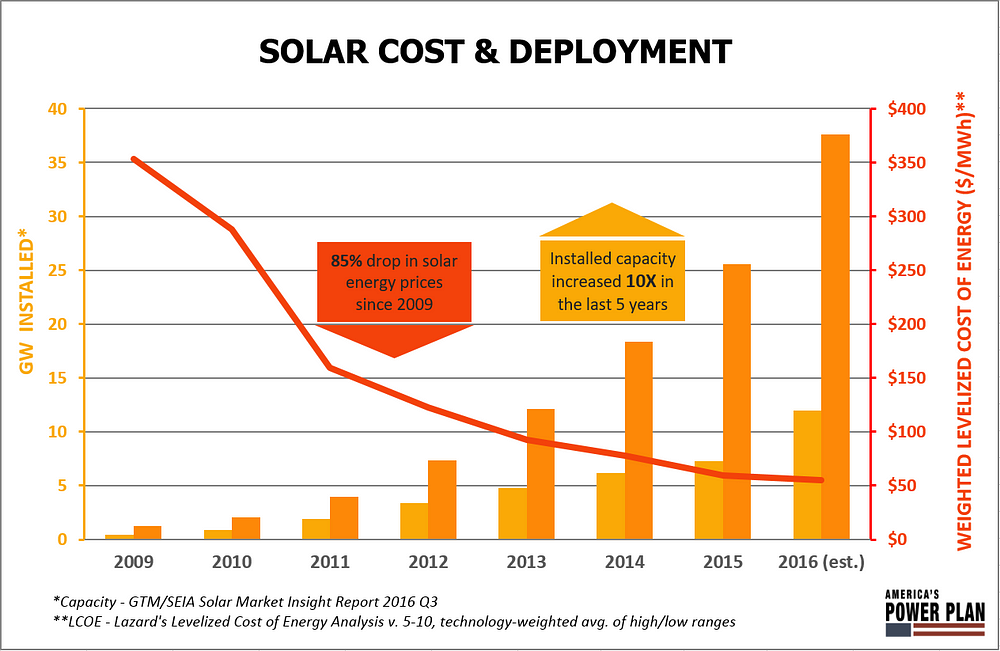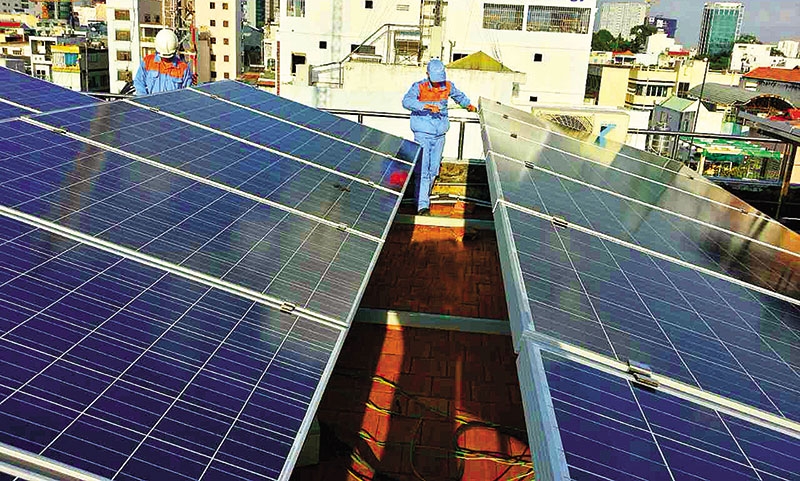
By Mike O’Boyle For years, debates about how to reduce carbon emissions from electricity generation were framed as trade-offs: What is the cost premium we must pay for generating zero-carbon electricity ...
By Mike O’Boyle
For years, debates about how to reduce carbon emissions from electricity generation were framed as trade-offs: What is the cost premium we must pay for generating zero-carbon electricity compared to fossil fuels, and how can we minimize those costs?
Fortunately, the holidays came early this year for renewable energy in investment company Lazard’s annual report on the levelized cost of energy (LCOE) for different electricity-generating technologies — renewables are now the cheapest available sources of electricity. This flips the question of clean versus cost on its head, and in 2017, we’ll be asking how much can we save by accelerating the renewable energy transition?
The story from Lazard’s 10th annual report is clear. Rapid technology cost reductions mean wind and solar are now the cheapest form of generation in many places around the country, without counting federal subsidies like tax credits.
What is levelized cost of energy?
Lazard uses the LCOE analysis to identify how much each unit of electricity (measured in megawatt-hours, or MWh) costs to generate over the lifetime of any power plant. LCOE represents every cost component — capital expenditure to build, operations & maintenance, and fuel costs to run — spread out over the total megawatt-hours generated during the power plant’s lifetime.
Because different plants have different operating characteristics and cost components, LCOE allows us to fairly compare different technologies. Think of it as finally being able to evenly compare apples to oranges.
How wind and solar are winning the day
According to Lazard, wind costs have fallen 66 percent since 2009, from $140/MWh to $47/MWh.

Large-scale solar’s cost declines have been even more dramatic, falling 85 percent since 2009 from more than $350/MWh to $55/MWh.

Compare this with the cheapest form of conventional fuel-fired generation today — natural gas-fired combined cycle power plants whose LCOE averages $63/MWh.

The case is even clearer when federal subsidies are considered: Tax credits drive renewable energy’s costs down to $31/MWh for wind and $43/MWh for solar. These low prices are not only cheaper than building new natural gas plants, but they are cheaper than many fossil fuel power plants on their marginal cost (i.e. costs for operating, maintaining, fueling, etc.) alone.
In other words, it’s now cheaper in many places to build new wind or solar energy than it is to simply continue running an existing coal and nuclear plant:

What does it all mean?
Even with these new numbers, more natural gas plants are being built every week, expensive coal is not retiring as fast as economics would dictate, and the rapid transition to renewable energy isn’t happening fast enough to prevent the worst effects of climate change.
At least three stodgy institutional barriers limit renewable energy deployment today: 1) difficulty accessing high-quality wind and solar resources, 2) misguided alarmism about the reliability of renewables, and 3) misconceptions of the cost of running the grid with more renewables.
While just wind and solar alone could potentially power the entire U.S. many times over, the windiest and sunniest (and thus cheapest) places to generate wind and solar power are often in remote locations, far from large cities with lots of power demand. Costly, drawn-out processes for siting transmission and power plants make these projects unnecessarily expensive and stifle investment. Policymakers can turn to America’s Power Plan for recommendations on streamlining the siting process and limit local impacts to create policy that reduces siting costs for renewables in the U.S.
Managing America’s grid with variable renewables also requires rethinking how we operate and plan our electricity systems, and many utilities have been slow to adapt. Grid operators sometimes claim we need to back up solar and wind an equal ratio of fossil fuel power plants like coal or gas for “when the sun doesn’t shine and the wind doesn’t blow”, but that’s just not true. Adding wind and solar can reduce the risk of a large outage — what are the odds the wind unexpectedly stops blowing everywhere or the sun is suddenly blotted out by clouds everywhere? In fact, government analysis shows we could quadruple the amount of wind and solar on the grid today without running into reliability issues.
Besides reliability, defenders of the old paradigm of large, fuel-fired power plants argue wind and solar come with integration costs, i.e. backup generation and transmission lines to connect remote locations to the grid. But attributing these costs to any one technology makes little sense across a big grid, where a diverse mix of power generation naturally smooths variability like an index fund versus a single volatile stock, for example. Gas, coal, and nuclear power also require new transmission, fuel supply and storage, and large backup reserves. Like renewable sources, they also have “integration costs,” even without accounting for the health and climate costs of carbon dioxide and other pollution.
A new paradigm
Transitioning our electricity sector away from fossil fuels is no longer just an environmental imperative, it’s an economic one. Free markets now favor solar and wind — look no further than gas-rich Texas for evidence. Texas has more than three times more wind capacity than any other state, and solar is expected to grow 400 percent by 2022.
Outdated policies leave us unprepared to take full advantage of the rapid cost declines we’re seeing in the wind and solar industry. The time is now to radically adjust for a paradigm where wind and solar form the backbone of our electricity grid.
Source: https://medium.com/americas-power-plan/wind-and-solar-are-our-cheapest-electricity-sources-now-what-do-we-do-b323082239de#.a4f3y8umk





.png)


